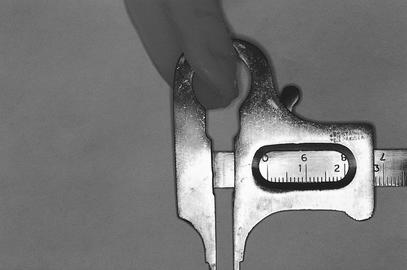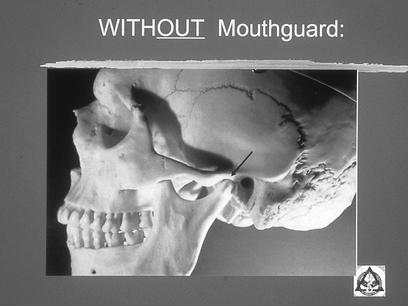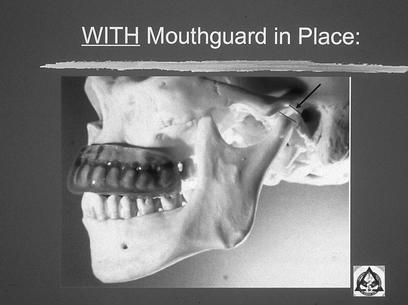For many years, some experts have speculated that if athletes wear mouthguards in contact sports, many sport-related cerebral concussions might be prevented. The key reference for this position was a 1964 article in the Journal of the American Dental Association by Stenger et al.1 Many other positions on the subject were established, most significantly by Hickey et al2 in 1967 and by Chapman3,4 in 1985 and 1990. Although no controlled experimental study has confirmed or refuted the idea that a properly fitted mouthguard reduces the likelihood of sustaining a concussive injury, evidence is mounting that the device could play a significant role in this critical area of player safety.
As sports and our culture evolve, the techniques of playing and coaching the activities improve. Today, there are more participants, both men and women, in recreational and organized sports. Players are bigger, stronger, and faster than their predecessors. The desire to win at all levels of competition, the number of college scholarships available, and the money professional athletes are making have created an environment more conducive for athletic injuries. With the new awareness and media attention being paid to such injuries, sport-related concussion is surfacing as a major concern.
In addition to education, we can make the playing of sports safer for participants by changing the rules of the game and by improving or changing the equipment. It is to the improvement of the equipment that this paper is directed.
My perspective comes from two unique positions. As a pediatric dentist over the years, I have used many different types of mouthguards with my patients. As a college football referee in the Mid-American Conference for 18 years, I have on-field observations of the types and quality of the mandatory mouthguards the players have been wearing. The four types of guards most commonly used are (1) stock over the counter, not mouth formed, (2) boil and bite, well worn, mouth formed, (3) cut-off, no posterior tooth coverage, and (4) custom fabricated over a model of the upper dental arch.5 Through my involvement with the Academy for Sports Dentistry, I have discussed concussion prevention with many colleagues, including Dr John Stenger, and I have been able to establish the type of custom mouthguards constructed for the Notre Dame athletes in the 1964 study.1 Over the past several football seasons, I have been directly involved with a series of ongoing studies investigating the role that properly fitted, pressure-laminated mouthguards can play in reducing concussive forces applied to the brain.
The methods used in our studies follow the Academy for Sports Dentistry position statement for properly fitted mouthguards.6 The materials used were polyvinyl acetate copolymer (Dreve-Dentamid, Unna, Germany). Impressions were taken of the players' upper dental arches, and the protectors were fabricated over the models. The materials were formed with heat and pressure using a Drufomat machine (Westone Labs, Inc, Colorado Springs, CO). The posterior thickness varied from 3 to 4 millimeters in thickness after the final fitting (Figure 1).
Figure 1.
Properly fitted, pressure-laminated mouthguard with 3 to 4 mm of thickness posteriorly.
Concussions result from the sudden acceleration or deceleration of the brain because of either direct or indirect (eg, rotational) forces. The strength of this force and its effect on the brain are directly related to the absolute value of the acceleration. From newtonian physics, acceleration refers to change in velocity, which is expressed in terms of units of time over units of distance:
In this formula, the letter a refers to acceleration, v0 to initial velocity before the start of acceleration, v to the speed at the end of acceleration, and s to the distance traveled during acceleration. Consider that newtonian physics also supply the formula
where F signifies the force applied, m the mass of the object involved in the contact, and a the acceleration. As such,5
The unproven theory applied in this study, and essentially in the 1964 study by Stenger et al,1 is that the properly fitted mouthguard effectively increases the time and distance involved in acceleration when the mechanism of injury is an upward blow to the head through the mandible. Note the separation in the pictures, with and without a properly fitted mouthguard in position, as well as the head of the condyle in relation to the base of the skull (Figures 2, 3).
Figure 2.
Note head of condyle and base of the skull without a properly fitted mouthguard. Figure courtesy of the Academy for Sports Dentistry.
Figure 3.
Note separation in space between the head of the condyle to the base of the skull with a properly fitted mouthguard in place. Figure courtesy of the Academy for Sports Dentistry.
The brain is a very difficult organ to study, and one must realize that concussions will likely always occur in collision and contact sports, such as football. Many factors are involved in reducing athletes' vulnerability to concussion, including genetics, anatomy, force of the blows, mass of the players, other equipment and rule changes, playing surfaces, coaching techniques, players being in harm's way when a force is present, and increasing knowledge about what constitutes a concussion.
At a time when clinicians and researchers are looking for answers to this very intriguing problem of sport-related concussion, it is important not to overlook some very obvious solutions. Although the techniques of fabrication and the materials have changed, the wheels of thought are returning 360 degrees to the 1960s and the study by Stenger et al.1 Plastic face masks attached to helmets have reduced the incidence of dental and facial injuries in football; thus, the importance of wearing a mouthguard for concussion prevention may have been ignored. For example, mouthguards are not required equipment for National Football League players.7 My contention is that over the past 35 years, quality has been sacrificed in exchange for a quick fix, ie, low-cost, ill-fitting mouthguards. These mouthguards do not hold their shape and fit so poorly that athletes sometimes alter them for speaking and comfort, forgoing the posterior thickness that might provide needed protection if a blow was delivered to the mandibular complex.5
Are properly fitted, pressure-laminated mouthguards an answer? Time will tell. Some of the preliminary work comparing the 1997 through 1999 NCAA college football seasons suggests that they have made a difference. The laminated mouthguards do not break down with use, and players do not tend to abuse or alter them. If a problem develops, correcting or reconstructing the mouthguard on the basis of the original model can easily be accomplished. In my opinion, and that of many other Academy for Sports Dentistry members, the theory makes sense. A posterior separation of 3 to 4 mm relates nicely to the newtonian laws of physics. This thickness converts to time and distance, over which acceleration occurs if a blow is delivered to the madibular complex.
CONCLUSIONS
From this theory and some of our early findings, it would appear that greater emphasis should be placed on the thickness in the posterior occlusal areas, especially in those high-contact sports requiring the use of mouthguards. Education of all those involved is the key. Team physicians, dentists, athletic trainers, and coaches must take into consideration both the athlete's previous medical history and the sport. Our emphasis must be on improving the quality of mouthguards for player safety as one way of attempting to reduce the incidence of concussion in athletes.
REFERENCES
- 1.Stenger J, Lawton EA, Wright J, Ricketts J. Mouthguards: protection against shock to head, neck and teeth. J Am Dent Assoc. 1964;69:273–281. doi: 10.14219/jada.archive.1964.0290. [DOI] [PubMed] [Google Scholar]
- 2.Hickey JC, Morris AL, Carlson LD, Seward TE. The relation of mouth protectors to cranial pressure and deformation. J Am Dent Assoc. 1967;74:735–740. doi: 10.14219/jada.archive.1967.0145. [DOI] [PubMed] [Google Scholar]
- 3.Chapman PJ. Concussion in contact sports and importance of mouthguards in protection. Aust J Sci Med Sport. 1985;17:23–27. [Google Scholar]
- 4.Chapman PJ. Orofacial injuries and international rugby players' attitudes to mouthguards. Br J Sports Med. 1990;24:156–158. doi: 10.1136/bjsm.24.3.156. [DOI] [PMC free article] [PubMed] [Google Scholar]
- 5.Barth JT, Freeman JR, Winters JE. Management of sports-related concussion. Dent Clin North Am. 2000;44:67–83. [PubMed] [Google Scholar]
- 6.Academy for Sports Dentistry. Position statement: a properly fitted mouthgard. 1998. Dec 6, Available at: http://www.acadsportsdent.org/position.htm. Accessed May 21, 2001.
- 7.1999 Official Playing Rules of the National Football League. Tarrytown, NY: Triumph Books; 1999. [Google Scholar]





